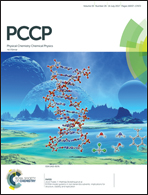Efficient scavenging of Criegee intermediates on water by surface-active cis-pinonic acid†
Abstract
cis-Pinonic acid (CPA), the main product of the atmospheric oxidation of biogenic α-pinene emissions and a major component of secondary organic aerosol (SOA), is a potentially key species en route to extremely low volatility compounds. Here, we report that CPA is an exceptionally efficient scavenger of Criegee intermediates (CIs) on aqueous surfaces. Against expectations, millimolar CPA (a surface-active C10 keto-carboxylic acid possessing a rigid skeleton) is able to compete with 23 M bulk water for the CIs produced in the ozonolysis of sesquiterpene solutes by O3(g) on the surface of a water:acetonitrile solvent. The significance of this finding is that CPA reactions with sesquiterpene CIs on the surface of aqueous organic aerosols would directly generate C25 species. The finding that competitive reactions at the air–liquid interface depend on interfacial rather than bulk reactant concentrations should be incorporated in current chemical models dealing with SOA formation, growth and aging.

- This article is part of the themed collection: 2017 PCCP HOT Articles


 Please wait while we load your content...
Please wait while we load your content...